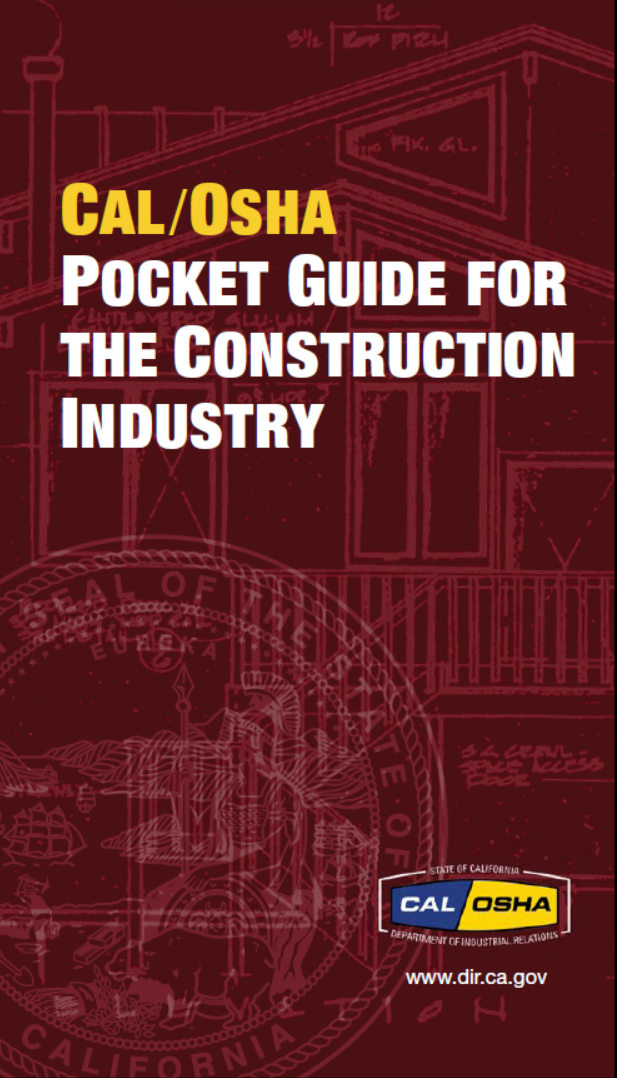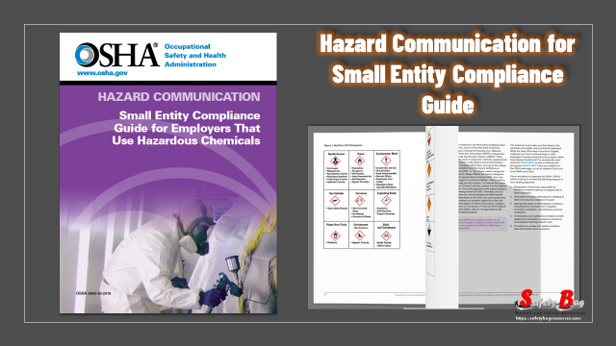CA/OSHA Pocket Guide for the construction industry does not provide full legal interpretation of Cal/OSHA regulations or their underlying statutes.
The construction industry involves many types of work activities covered by numerous regulations in title 8 of the California Code of Regulations (T8 CCR). T8 CCR contains detailed information on regulations and workplace safety programs, including specifications and exceptions. Construction employers may have requirements in the Construction Safety Orders (CSOs), Electrical Safety Orders (ESOs), Tunnel Safety Orders (TSOs), Compressed Air Safety Orders (CASOs), and the General Industry Safety Orders (GISOs).
To assist the construction industry in working safely and complying with title 8 regulations, the Cal/OSHA Publications Unit has updated this Pocket Guide. This guide is intended to be used as a reference for workers, employers, supervisors, job stewards, safety personnel, and others. This Pocket Guide:
- Summarizes safety requirements from T8 CCR that apply to the construction industry. It is not meant to be either a substitute for or a legal interpretation of the occupational safety and health regulations in T8 CCR (see T8 CCR or detailed information).
- Lists the major subject headings in alphabetical order in the Table of Contents, and each subject heading is linked to its content.
- Provides highlights of selected safety standards in each major subject heading within its scope and may also include best practices in safety and health.
- Is not all-inclusive. The contents under the bullets, lists, notes and exceptions are highlights of regulatory requirements, best practices, and other construction safety and health information. Readers should refer directly to T8 CCR for complete information.
- Contains abbreviations as described in the List of Acronyms section. It is available in PDF format and can be printed online.
Read the CAL/OSHA Pocket Guide for Construction Industry Flipping book :
Workplace Safety and Health
- Proactive safety and health programs are an effective way to prevent workplace injuries and illnesses and reduce the costs of doing business. In such programs, employers and employees work together to ensure that safety and health are always part of the decisions made and all employees and supervisors are fully trained to work safely. The benefits of effective, proactive safety programs include
- higher productivity and employee morale,
- higher quality of work and products produced,
- fewer worker injuries,
- lower compensation insurance cost and absenteeism, and
- lower employee turnover.
A written Injury and Illness Prevention Program (IIPP) should be the foundation for all of your other safety and health programs and is required for every workplace regulated under title 8 of the California Code of Regulations (T8 CCR). A summary of the basic elements of an IIPP has been included in the Injury and Illness Prevention Program section of this guide. Employers are also encouraged to use Cal/OSHA’s IIPP eTool (www.dir.ca.gov/dosh/etools/09-031/index.htm) to develop a specific IIPP tailored to their own workplaces.
The Content
- About This Pocket Guide …………………………………………………… 4
- Workplace Safety and Health……………………………………………… 4
- Access ……………………………………………………………………………. 5
- Administrative Requirements ……………………………………………… 7
- Aerial Devices and Elevating Work Platform Equipment………… 11
- Airborne Contaminants and Dust ………………………………………. 12
- Air Compressors…………………………………………………………….. 13
- Asbestos ………………………………………………………………………. 13
- Blasting (Abrasives/Sand)………………………………………………… 18
- Blasting (Explosives) ………………………………………………………. 18
- Carcinogens ………………………………………………………………….. 20
- Code of Safe Practices ……………………………………………………. 21
- Competent Person………………………………………………………….. 21
- Concrete Construction …………………………………………………….. 21
- Confined Spaces ……………………………………………………………. 26
- Corrosive Liquids……………………………………………………………. 29
- Cranes………………………………………………………………………….. 29
- Demolition …………………………………………………………………….. 38
- Dust, Fumes, Mists, Vapors, and Gases …………………………….. 40
- Electrical……………………………………………………………………….. 41
- Elevators, Lifts, and Hoists ………………………………………………. 46
- Emergency Medical Services……………………………………………. 47
- Engine Exhaust Emission ………………………………………………… 48
- Erection and Construction………………………………………………… 48
- Ergonomics in Construction ……………………………………………… 52
- Excavation, Trenches, and Earthwork………………………………… 53
- Explosion Hazards………………………………………………………….. 62
- Fall Protection………………………………………………………………… 63
- Fire Protection and Prevention………………………………………….. 68
- First Aid ………………………………………………………………………… 69
- Flaggers ……………………………………………………………………….. 69
- Flammable and Combustible Liquids …………………………………. 70
- Forklifts…………………………………………………………………………. 71
- Forms, Falsework, and Vertical Shoring……………………………… 73
- Guardrails……………………………………………………………………… 75
- Hazard Communication Program (HAZCOM)………………………. 77
- Heat Illness Prevention ……………………………………………………. 79
- Heavy Construction Equipment…………………………………………. 87
- Hot Pipes and Hot Surfaces……………………………………………… 89
- Housekeeping/Site Cleaning…………………………………………….. 90
- Injury and Illness Prevention Program………………………………… 90
- Ladders ………………………………………………………………………… 93
- Laser Equipment…………………………………………………………….. 98
- Lead …………………………………………………………………………….. 99
- Lighting……………………………………………………………………….. 102
- Lock-out/Block-out Procedures ……………………………………….. 103
- Machine Guarding ………………………………………………………… 106
- Multi-employer Worksites……………………………………………….. 106
- Personal Protective Equipment ……………………………………….. 107
- Pile Driving ………………………………………………………………….. 109
- Pressurized Worksites …………………………………………………… 111
- Qualified Person …………………………………………………………… 112
- Ramps and Runways…………………………………………………….. 113
- Roofing Operations……………………………………………………….. 113
- Scaffolds……………………………………………………………………… 118
- Silica Dust …………………………………………………………………… 132
- Stairways …………………………………………………………………….. 133
- Temporary Agencies……………………………………………………… 134
- Toeboards …………………………………………………………………… 135
- Toilets/Washing Facilities/Sanitation ………………………………… 136
- Tools and Equipment …………………………………………………….. 137
- Traffic Control………………………………………………………………. 143
- Training ………………………………………………………………………. 143
- Tunnels and Tunneling ………………………………………………….. 145
- Welding, Cutting, and Other Hot Work ……………………………… 147
- Wood Preservative Chemicals ………………………………………… 150
- Work Over or Near Water ………………………………………………. 151
- List of Acronyms …………………………………………………………… 152
- Index ………………………………………………………………………….. 155
Also, Read Books: OSHA Fall Protection Toolbox Talks and Trainer Guide
Download The Book
Books: CAL/OSHA Pocket Guide for construction Industry
More Downloads
- Books: How to Plan for Workplace Emergencies and Evacuation
- Books: Firefighting Precautions at Facilities with Combustible Dust
- Books: A Guide to Electrical Safety
- Books: Preventing Falls in Scaffolding Operations
- Handbook: Worker’s Safety
- Books: A Guide to Safety in Confined Spaces
- Books: OSHA-Hazard communication for small Entity
- Books: OSHA-Permit Required Confined Spaces
- OSHA: Underground Construction (Tunneling)
- OSHA Recommended Practice of Health and Safety programs in construction
- Books: OSHA-Is it Safe to Enter Confined Space?
- Books: General Industry Digest
- Books: A Guide to Bloodborne Pathogens in the workplace
- Books: 5-Minute Workplace Safety Talks
- CAL/OSHA Scaffold Guide for safe use of supported Scaffolds
- Books: CAL/OSHA Pocket Guide for Construction Industry
- OSHA Programs: Aerial Lifts Safety Program-UK University
- Programs: Stairways and Ladders A Guide to OSHA Rules
- Books: Let’s Talk Safety
- Books: OSHA Fall Protection Toolbox Talks and Trainer Guide
- Booklet: Electrical Safety Worksite Do’s and Don’t


